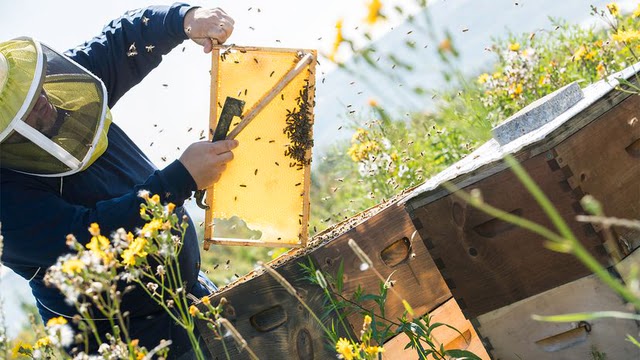Quck answer
Beekeeping, also known as apiculture, is the practice of raising and tending to bees for their honey, beeswax, and pollination services. A beekeeper will typically keep one or more colonies of bees in a hive, which is a specially designed box that provides shelter and protection for the bees. Inside the hive, the bees will build comb and store honey, pollen, and brood (young bees). The beekeeper will periodically inspect the hive to ensure the health of the colony and to harvest honey and beeswax. Beekeeping requires knowledge of bee behavior and biology, as well as proper equipment and safety precautions.
Wild Animals

The relationship between humans and bees has been in existence for centuries. The honeybee colonies are known to be highly productive, with individual worker bees taking on multiple roles in their six-week life span. The bees’ efforts are geared towards producing honey, which serves as a vital energy source to help the colony survive the winter.
Beekeeping involves the art and science of extracting honey without disrupting the bees’ natural habitat. Beehives may be manmade, but the bees remain wild animals, doing what evolution has taught them to do. Beekeepers strive to keep the bees healthy and happy as they collect profits from the honey.
The Growing Popularity of Beekeeping
Beekeeping is becoming increasingly popular, with over 2.67 million honeybee colonies in the United States alone. Previously considered a hobby for rural farmers and hermit monks, it has become a trendy pastime for urban lifehackers and suburbanites. The initial investment in hive boxes, beekeeping equipment, and bees is minimal, requiring only about 30 minutes of attention per week and two annual harvests. The attraction of beekeeping lies in the thrill of interacting with stinging insects and the reward of collecting jars of honey.
However, beekeeping is not as easy as it seems, with unpredictable weather, pests, and diseases posing significant challenges. Beekeepers must learn to screen for and treat these issues, and bees can be aggressive and sting frequently.
The Importance of Finding a Mentor
The best advice for anyone interested in beekeeping is to find a mentor. Most localities have beekeeping societies, and joining one can provide invaluable resources. Experienced beekeepers can offer guidance and assistance in loading bees into the hive, assessing brood frames, and spotting queen cells. With the right support, anyone can become a beekeeper and experience the satisfaction of producing honey.
The Ancient Partnership between Humans and Bees
For thousands of years, people have maintained a special agricultural bond with bees, whether or not the insects are conscious of it. To understand this connection, we need to delve into the past and visit the earliest beekeepers.
FAQ
1. What is beekeeping?
Beekeeping is the practice of maintaining and caring for bees, primarily for the production of honey, beeswax, and other bee-related products. It involves providing bees with a safe and healthy environment, managing their hives, and harvesting their products for human use.
2. Why is beekeeping important?
Beekeeping is important for many reasons. Bees are crucial pollinators, helping to fertilize plants and crops that make up a significant portion of the world’s food supply. Additionally, bee products like honey, beeswax, and propolis have many uses in medicine, cosmetics, and food production.
3. How do bees make honey?
Bees make honey by collecting nectar from flowers and storing it in their honey stomachs. Once back at the hive, the bees regurgitate the nectar and pass it from bee to bee, adding enzymes that break down the sugars and help evaporate the water. The resulting honey is stored in honeycomb cells and sealed with beeswax.
4. What equipment is needed for beekeeping?
Beekeeping requires a few essential pieces of equipment, including a hive, protective clothing, a smoker, and a hive tool. The hive is where the bees live and where the beekeeper can inspect and manage the colony. Protective clothing, like a bee suit and gloves, helps to keep the beekeeper safe from stings. A smoker is used to calm the bees, making them less likely to sting, and a hive tool is used to pry apart the hive components.
5. What are the different types of hives?
There are several types of hives used in beekeeping, including Langstroth, top-bar, and Warre hives. Langstroth hives are the most common and consist of stacked boxes with removable frames. The bees build their combs on these frames, making inspection and honey harvesting easier. Top-bar hives have bars instead of frames and are better suited for smaller colonies. Warre hives are similar to Langstroth hives but are designed to mimic the natural shape of a honeycomb.
6. How do you care for bee colonies?
Caring for bee colonies involves monitoring the hive for signs of disease, ensuring that the bees have access to enough food and water, and managing pests like mites and wax moths. Beekeepers also need to provide a safe and healthy environment for their bees, which may involve protecting them from extreme weather conditions and reducing exposure to pesticides and other chemicals.
7. How is honey harvested?
Honey is harvested by removing the frames from the hive and extracting the honey from the comb. This can be done using a centrifuge or by crushing the comb and straining out the honey. Once the honey has been harvested, the frames are returned to the hive for the bees to rebuild their combs and continue producing honey.
8. Can anyone become a beekeeper?
Anyone can become a beekeeper with some education and dedication. Beekeeping requires a significant amount of time, effort, and expense, so it’s important to do your research and understand the commitment involved. Additionally, some areas may have regulations or restrictions on beekeeping, so it’s important to check with your local government before starting a hive.





Leave a Reply